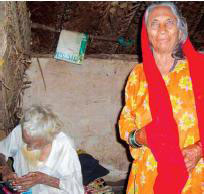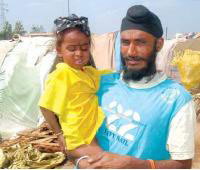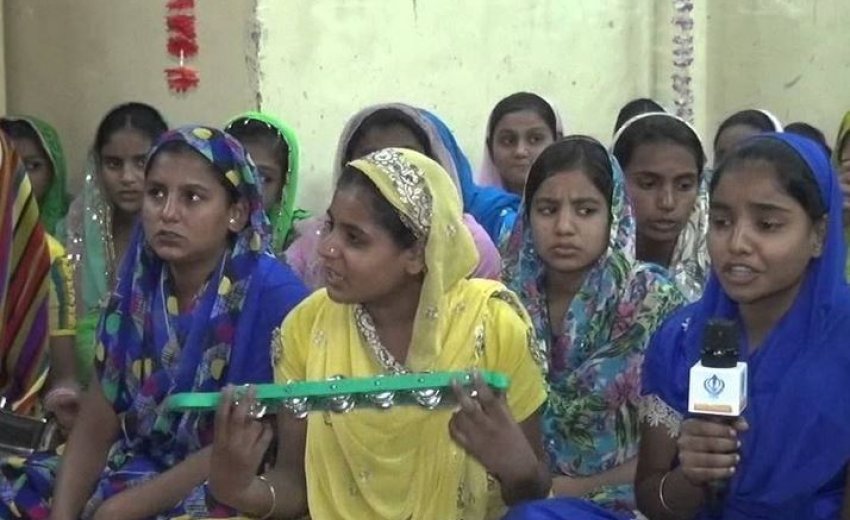 From the outskirts of Sholapur in Maharashtra to the periphery of the beautiful Mysore city in the state of Karnataka, I continued my search for the Sikligar Sikh habitat. Accompanied by my wife, we made a tour of the area, but were embarrassed of our cleanliness in the face of the terrible conditions in which the 20-odd families were surviving there.
From the outskirts of Sholapur in Maharashtra to the periphery of the beautiful Mysore city in the state of Karnataka, I continued my search for the Sikligar Sikh habitat. Accompanied by my wife, we made a tour of the area, but were embarrassed of our cleanliness in the face of the terrible conditions in which the 20-odd families were surviving there.
Describing poverty is painful.
I was aghast at their determination and hard work. Four year old Rahul Singh had dropped out of school after severe beating by a teacher for reasons he could not understand. He was now beating iron to augment the family income. His father Ajit Singh says, "He never misses an opportunity to hold the hammer. As soon as I take a respite, he is ther e". I asked the child, "This is too heavy for you, don't you get tired?" He said, "No".
e". I asked the child, "This is too heavy for you, don't you get tired?" He said, "No".
Then I asked him, "what do you want to become in life? "Dharmendra", pat came the reply. His elder sister, Roshni Kaur, another school dropout, spends the whole day watching television, as she too is too shy to go to school. The mother says, she will endeavour to send her both the children to school next year.
Three year old kid Lucky Singh is not so lucky. He cannot open his eyes in daylight. The sun pinches him and he keeps weeping. Come dusk and he sees like a normal person. He suffers from a peculiar eye ailment. While we were touring the settlement, our guide Ajit Singh wanted us to meet the Naana.
He is an 85 year old man -Durga Singh and the 20 families that live here are his clan. He is bedridden after having met an accident. He is blind too. His wife, Raj Kaur, takes care of him and has been doing so for the last many years.
Most men are off to work when we visit. Some have gone to other cities and states, as far as Coimbatore, where they have relatives to stay -to sell their wares as ther e is less demand for the iron agricultural tools that they make in Mysore. They have been residing in this area, officially called Hutments, (as per the Electoral Rolls records) in the Varnimathram area of the city, after they came from Davengere -another Karnataka town, some fifteen years ago. They have work for 10-12 days in a month.
e is less demand for the iron agricultural tools that they make in Mysore. They have been residing in this area, officially called Hutments, (as per the Electoral Rolls records) in the Varnimathram area of the city, after they came from Davengere -another Karnataka town, some fifteen years ago. They have work for 10-12 days in a month.
The younger children, about eighteen of them, go to school, courtesy the education sponsorship programme of the Karnataka Sikh Welfare Society. The adolescents want to supplement the family income and therefore remain unlettered.
The only escape from the stark realities of life for the hundred-odd residents of this ghetto, living amidst other communities similarly placed, is television with cable connections purchased through the nose under daily installment payment schemes. Huddled in the foreground of Ajit Singh's hut, I gathered the womenfolk and asked them, "Would they like to study? Would they take the lead and make a difference to their lives through education?" With a spark in their eyes, "Yes, provided the teacher comes here" they all said.
Huddled in the foreground of Ajit Singh's hut, I gathered the womenfolk and asked them, "Would they like to study? Would they take the lead and make a difference to their lives through education?" With a spark in their eyes, "Yes, provided the teacher comes here" they all said.
Someone desperately needs a temporary tin sheet over their thatched roof; the women need the privacy of a washroom, the kid with the eye ailment needs medication and the old man desperately needs care, hospitalization and an operation. All of them need education, empowerment, encouragement, dignity, a sense of affinity from the Sikhs at large and a decent dwelling.
Jagmohan Singh is a commentator based in Ludhiana. He may be contacted at [email protected]
